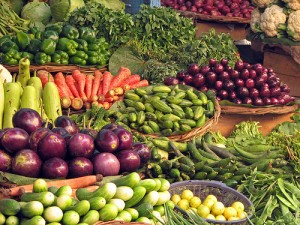The golf season is waning, Daylight Savings Time is trudging up the 18th hole, and Seasonal Affective Disorder (SAD) will begin kicking in due to decreased sunlight up here in the northern climates. We’ll want to eat….and eat….and eat. It is natural to crave more food in the winter so don’t beat yourself up for following the natural instinct to chow down; after all, many animals go into hibernation but before they do, they gorge themselves to pep up their reserves and body fat to last through the long winter. We may cocoon ourselves inside our homes to deal with cold and harsh weather, but don’t fall into the trap of eating as if you are hibernating: the bears eat nothing when they are asleep. We eat every day…..and don’t play much golf in the winter, walking and carrying our bag of course, to use up the calories.
We’ve come off of a great harvest of wonderful fruits and vegetables from a Michigan summer. Heavy rains in June and September made for a strange growing season but when the produce started to arrive, it poured in all at once. As much as we would like to continue using fresh fruits and veggies over the winter, unless you have canned or frozen your fresh food bounty, there isn’t much available. Now, you may say, ‘What, Janina, have you gone batty? There is fresh produce all over the supermarkets!’ True. However, most of those fruits and vegetables are grown out of country and brought in from who-knows-where. And, it is simply not optimal to eat certain foods out of season – nor justify the cost of transporting them all over the country.
Mother Nature has her reasons for ripening food as she does; we are supposed to eat a variety of foods at different times of the year, not force-feed ourselves whatever we want whenever we want. Most of you remember a time when we could not ever get sweet corn in February or strawberries in December. Some of you may even recall getting an orange for Christmas and treasuring it. We are spoiled – and we know it.
Many countries use growing methods, unsanitary practices, and pesticides you won’t like so it is best to avoid foods from these areas. Following is a list of foods you should never eat out of season:
1) Fresh peas are best eaten in the spring. They are ripe only for about two weeks. After that, nutrients are lost and they get starchy. Buy frozen, with little or no added salt.
2) Sweet corn is perfect in late summer when it is at its sweetest. Eat or freeze corn immediately before the sugar turns to starch. Don’t overcook: 2-3 minutes at most.
3) Every variety of mushroom has a season: morels in the spring, truffles in the fall, others in between. Don’t wash them – they absorb water. Trim the ends and brush the dirt off. Saute them in some butter and garlic for a little piece of ‘shroom heaven.
4) Early spring and summer is best for lettuces when they are crisp, sweet, and more nutritious; otherwise, experiment with other greens like kale, Swiss chard, spinach, and cabbages for salads. Bagged lettuces are treated with preservatives you don’t need.
5) Peach season is short: late August. Romeo, Michigan has an entire weekend devoted to the golden orbs. Eat them fresh or make no-sugar-added peach butters or preserves. Frozen? Forget it, they taste like cardboard. Jarred peaches are acceptable.
6) Wax beans become fibrous and tough in early fall; use green beans, which have a longer season. Buy frozen, never canned: those have the highest levels of BPA.
7) Asparagus is best only in spring, before stalks become woody. You can pickle them for a nice crunch but if you freeze it, only use it in cooked dishes.
8) Tomatoes are great fresh and full of lycopene (the heart protector) from August through October. Otherwise, forget those tasteless and pale impostors. Instead, buy crushed, in jars. If you have ever seen the rocky, sandy soil in which ‘hothouse’ tomatoes are grown, you’ll wonder how anything nutritious grows in such conditions.
If you’re wondering what you can eat, remember that certain vegetables do have a longer holding life: potatoes, sweet potatoes, onions, other root vegetables like rutabaga, turnips, beets, carrots, and celery root, and all varieties of gourds like squash and pumpkins.
The key to good health is to eat a variety of foods. There are enough around to offer choices for all 365 days of the year. And, when you travel to play golf, don’t hesitate to ask about fresh and local specialties – you’ll often be pleasantly surprised by the great taste and textures of foods you’ve never heard of.

